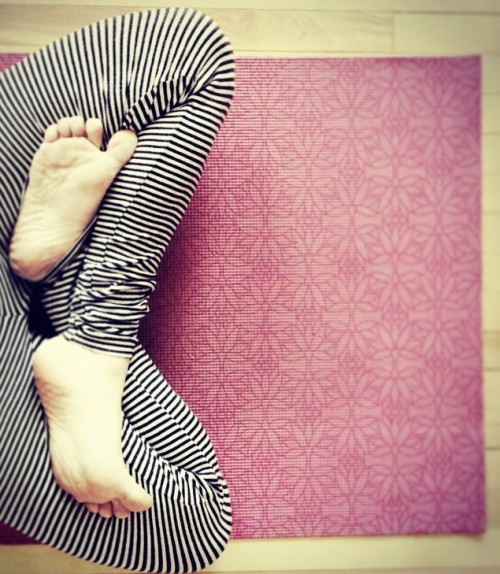There are so many benefits to having a consistent home yoga practice it’s kind of mind boggling.
A few of the more compelling reasons;
1) It’s free!
As a yoga instructor I probably shouldn’t point this out because my livelihood depends on you coming to my class, but I couldn’t forgive myself if I didn’t.
In a Lululemon world where single yoga classes average between $16 and $20, not to mention the gas it takes to get there, the coconut water we buy on a whim as we breeze into the studio and the lunch we grab afterwards because that awesome Mediterranean place is right next door, yoga can get pretty pricey.
And it’s all so unnecessary. The truth is, we can practice in our pj’s right in the middle of the living room and then eat left overs from the vegan mac and cheese we made last night just as easily.
2) We develop a much stronger awareness of self.
When our practice is exclusively about another person leading us, we never get the chance to find out where we might lead ourselves.
It’s kind of like trying to be an artist, but only painting stuff your art teacher assigns you. Though there is always a place for skilled instruction, at a certain point you learn more if you allow yourself room for exploration and mistakes.
3) Our practice becomes more integrated into our daily life.
When yoga becomes a familiar, routine activity that doesn’t require any fancy set up or prep we begin to think more like yogis from minute to minute.
In other words, the separation between life and yoga becomes smaller and smaller, until they begin to seem like one and the same thing– which really, is how it should be.
So how do we do it?
I can hear the protests already; I’m not disciplined! I don’t know enough about yoga! What if I don’t do it “right”?
Here is our chance to discover that everything we will ever need to know is already inside us; that we are strong and focused and disciplined and wise.
First, get the practical stuff in order.
Where and when to practice:
Designate a place in your home as your practice area. It is entirely irrelevant if you live in a studio apartment or 20,000 square foot mansion, all you need is somewhere big enough to roll out your mat.
I try and keep this area as neat and clean as possible, so when it’s time to get to work, I don’t spend an hour vacuuming and throwing out old newspapers first. I also keep my mat and my props right there, within easy reach.
Make sure it is a place with optimal (for you) light and temperature, and if necessary, have a fan or a space heater on hand. If you live with someone else, it’s great to find a spot where you can shut the door (unless they are a devoted yogi as well), and if you can’t manage that, pick a time to practice when you’re likely to be alone for the duration.
If you have room and are so inclined, decorate your space with sacred images, statues, candles, flowers and anything else that will get you in the mood. I have a colorful embroidery of the goddess Lakshmi (girl power!) in my space that I love. A small Buddha statue can go a long way toward making us feel like we are in the presence of something greater.
Before settling in, turn off all phones, computers, beepers, buzzers, screaming children and televisions. I try to get as far off the grid as I would in an actual yoga studio. We wouldn’t be caught dead checking our cell phone there, nor should we entertain the thought here.
*Note for yogi moms; if you don’t have the funds for a sitter, find a fellow broke yogi mom and agree to babysit for each other for an hour or two every other day. Someday, your kids will thank you.
Set a consistent schedule. I often write it down. We should honor this schedule as we would honor the class schedule at a studio. Chances are, we wouldn’t traipse in fifteen minutes late to a led class—nor should we do it if we’re on our own.
We’ve got our space, now what should we actually do in it?
The answer to this question will largely depend on your experience with yoga.
True beginners have a few options.
Take one led class per week and then practice x number of times a week on your own.
Subscribe to a live feed of a led yoga class (check the internet for a million amazing options for a fraction of the cost of a studio class), do that once a week and then practice x number of times a week on your own.
Or, sign up for one private yoga session per month (an average cost of $85) and explain to your instructor that your goal is to develop a home practice. Any teacher would be honored to help you on that journey, and though private sessions are expensive, you learn so much more in such a short amount of time, they are well worth it if you can afford them.
Also, once a month at $85 a class breaks down to just over $20 per week which is a great investment.
For anyone beyond a beginner.
1) Decide how much time you want to devote to practice today.
30 minutes is fine. An hour or an hour and a half is great. I glance at the clock when I get going and then try not to worry too much about it.
2) Get still.
We can be still in any position; seated, standing, laying down or in child’s pose. Find your breath. As you breath, feel your heart fill with gratitude. Remind yourself that you are wise and free.
3) Start to move.
Sun salutations are always a good place get our practice rolling, but we can do anything we want. We should link our breath to our movements. We can feel how wonderful it is the be the author of these movements, and how easy it is to stay in touch with our breath when it is just us, alone.
4) Walk the middle path.
We should challenge ourselves, but never over-do it. Always use medium effort.
Try to remember to include some version, however simple, of twists, back bends, inversions, standing poses, balances, and seated poses. Don’t worry if you forget something. There is always next time.
5) Rest.
Do not skimp on savasana. I spend at least five minutes here.
I tell myself to gently close my eyes and let my palms fall open. I relax my face, my chest, my belly, my arms, my hands, my knees and my feet. I allow my body to become heavy and sink into the floor.
6) Give thanks.
When finished, I slowly come to seated and place my palms together, remaining until I can clearly visualize the word “thank you” in my mind.
As our home practice develops, we begin to know and trust ourselves in a profound way. We can laugh at ourselves gently when we fall, and give ourselves a little nudge when we realize we are resisting a pose. We come to treasure this time as the time when we are at our most authentic and empowered.
There is always, as I said, a place for skilled instruction. A home practice does not have to replace a studio practice. But to become a truly well rounded, grounded, high functioning yogi, I believe some amount of home practice is essential.
More importantly, though, it is a chance to take an adventure into the wilds of our soul, to turn the stones inside ourselves over and see what’s hiding underneath, to find our place, our rhythm, our primal spirit, and to feel great and abundant gratitude for this singular life of ours.
Love elephant and want to go steady?
Sign up for our (curated) daily and weekly newsletters!
Editor: Bryonie Wise
Photo: Lauren Rudick









Read 2 comments and reply